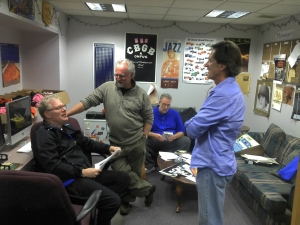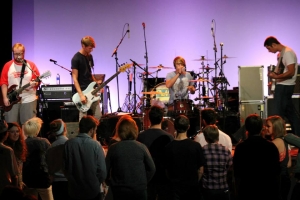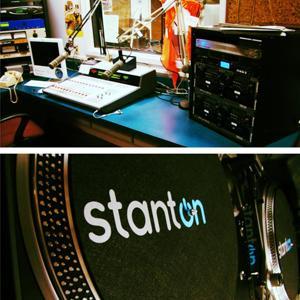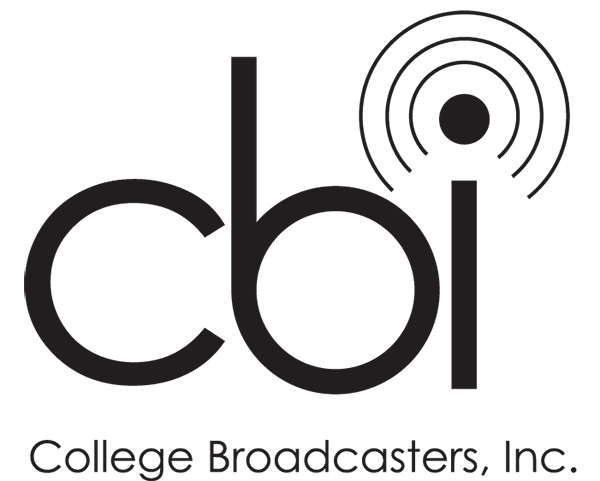March 27, 2014
Station Spotlight: University of Minnesota, Morris’s KUMM-FM
[fusion_builder_container hundred_percent=”yes” overflow=”visible”][fusion_builder_row][fusion_builder_column type=”1_1″ background_position=”left top” background_color=”” border_size=”” border_color=”” border_style=”solid” spacing=”yes” background_image=”” background_repeat=”no-repeat” padding=”” margin_top=”0px” margin_bottom=”0px” class=”” id=”” animation_type=”” animation_speed=”0.3″ animation_direction=”left” hide_on_mobile=”no” center_content=”no” min_height=”none”]

KUMM’s 40-year reunion in September 2012.
Special thanks to Taylor Robert Barker, general manager of KUMM-FM Radio for answering the questions!
Tell me a little history about your station and where your station is now.
We got our start in the late 1960’s when students from the University of Minnesota, Morris would produce a weekly program for the local commercial station. KUMM, as its own independent station, went on the air in September 1972 with a mighty ten watt output, broadcasting from a couple of closets in a campus dorm. By the 1980’s, we initiated the first of our power increases, jumping to 225 watts. At the same time, we converted to stereo and moved to our current location in the Student Center. In the 2000’s, we launched our tower relocation project, transferring our antenna from the top of the campus library to its present location atop the local water tower. Our authorized power levels increased yet again to 700 watts, allowing the surrounding underserved communities to enjoy our alternative programming. During those times, and ever since, we’ve been blessed with a student body that supports our technological investments, and we’ve had the chance to give back to the industry by serving as the Minnesota headquarters of College Radio Day.
What sets your station apart from other college radio stations?
One major difference is the unusual, but playful nature of our call letters, which has been a rich source of pride and tradition since our founding. We also get an extraordinary level of support that we get from other members of the noncommercial broadcasting world. KUMM has been a long-time member of Ampers, a network of fifteen independent public radio stations throughout Minnesota. Ampers, as an organization, is committed to furthering community-oriented programming, broader than the University that a station may be affiliated with. Ampers members also do their best to share ideas for success technically, financially, et cetera. That kind of support, especially when coupled with our ability to deliver high-quality statewide programming, makes us a rare gem in our field.
[/fusion_builder_column][fusion_builder_column type=”1_1″ background_position=”left top” background_color=”” border_size=”” border_color=”” border_style=”solid” spacing=”yes” background_image=”” background_repeat=”no-repeat” padding=”” margin_top=”0px” margin_bottom=”0px” class=”” id=”” animation_type=”” animation_speed=”0.3″ animation_direction=”left” hide_on_mobile=”no” center_content=”no” min_height=”none”]

A September 2013 KUMM concert.
Why did you choose to work at the radio station?
I’ve grown up in a family that treasures the time spent listening to the radio, and a lot of old jazz greats. From an early age, I was exposed to on air personalities from the Twin Cities and beyond, and I strove to be on that same level one day. To be invited into one’s home via airwaves is a sacred trust, and not being able to see the people you speak to is very challenging, but I wanted to see if I was capable.
What’s the craziest thing you’ve ever done for your station?
By far, the strangest thing I’ve ever done was my first radio show at KUMM. Our studios use iMacs, and my PC-groomed self wasn’t prepared to think in an entirely new way. Also, the precision that’s demanded when you talk or play things on the air was an entirely different ballgame than the theater I had cut my teeth in during high school. As such, the first show was a babbling mess, but that baptism by fire only made me more determined to get it right the next time.
[/fusion_builder_column][fusion_builder_column type=”1_1″ background_position=”left top” background_color=”” border_size=”” border_color=”” border_style=”solid” spacing=”yes” background_image=”” background_repeat=”no-repeat” padding=”” margin_top=”0px” margin_bottom=”0px” class=”” id=”” animation_type=”” animation_speed=”0.3″ animation_direction=”left” hide_on_mobile=”no” center_content=”no” min_height=”none”]

Inside the KUMM studios.
What’s the best part of college radio? And the hardest part?
I love college radio for the programming opportunities that are available — athletics, campus events, news, music — and the independent spirit that goes with it. Stations like ours aren’t chained to the repetitive requirements of the “Corporate Top-40,” leaving us free to concentrate on building a positive reputation with our campus and beyond. That being said, we lack the same obvious funding channels as a commercial station, which requires us to be creative … but hey, that’s where the fun is!
Want your station profiled for a CBI Station Spotlight? Email
Jessica Clary.
[/fusion_builder_column][/fusion_builder_row][/fusion_builder_container]






